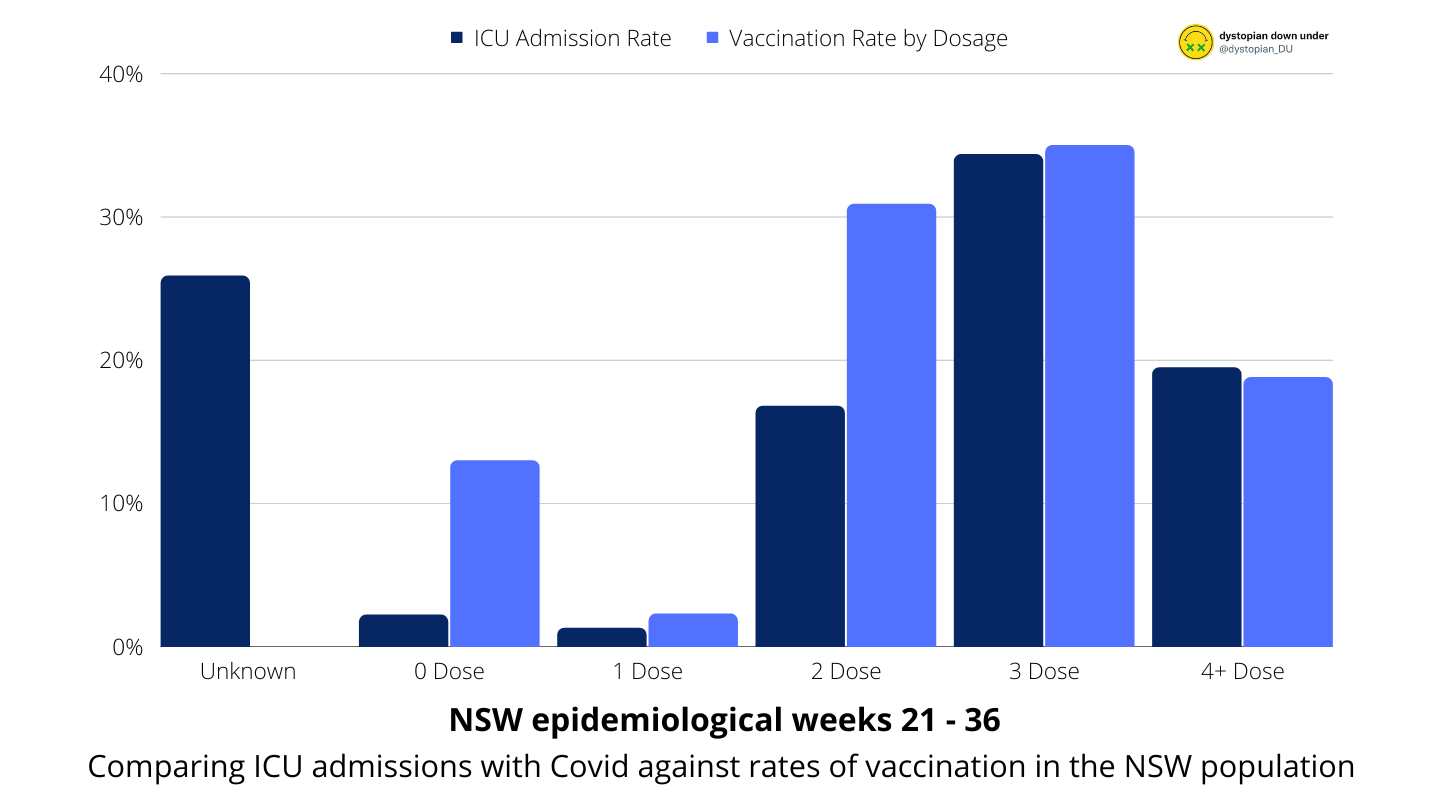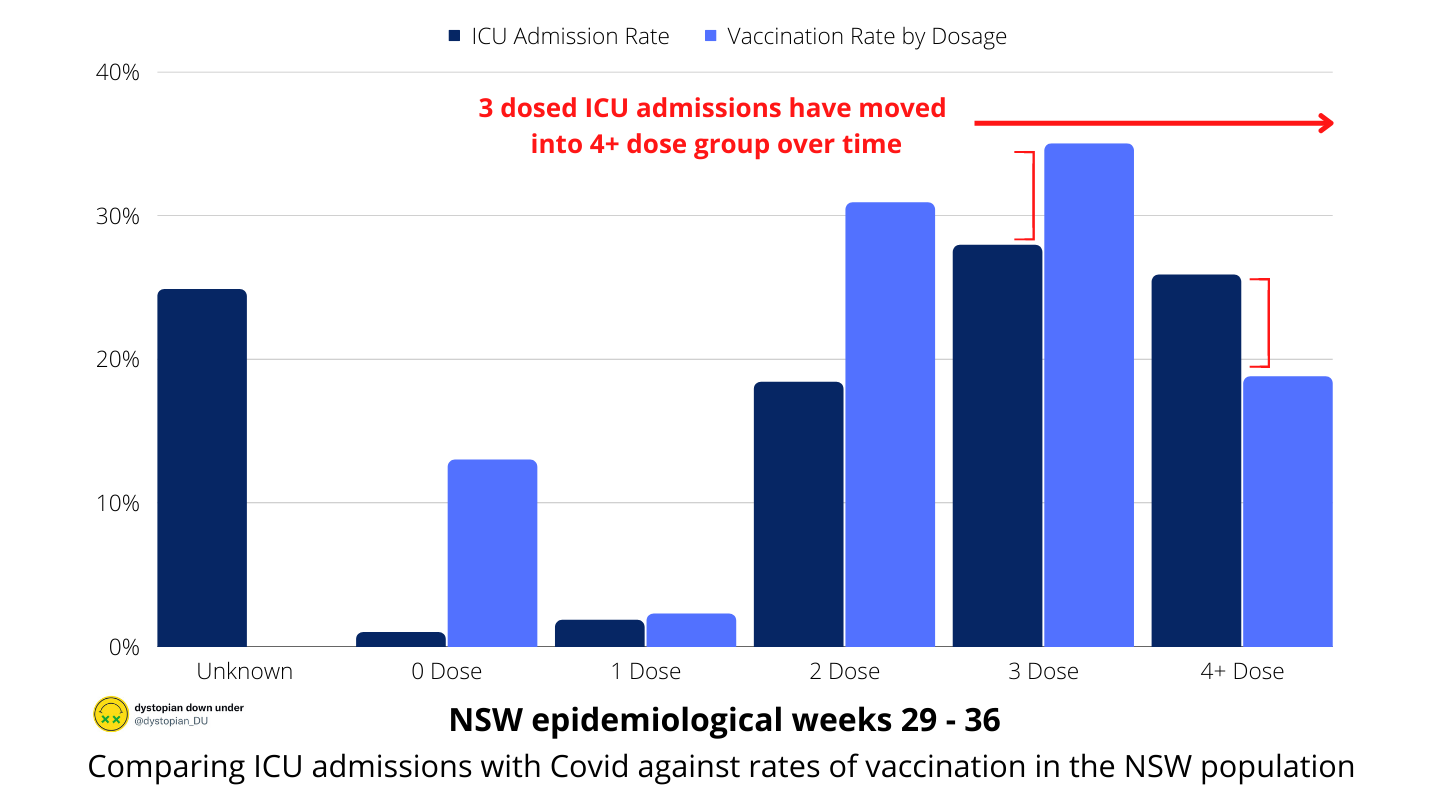NSW Health officials straight up lied about their own data in budget estimates
Susan Pearce, Secretary of NSW Health, says that ICU data shows, irrefutably, that Covid vaccines limit the severity of illness with Covid.
She says that the “irrefutable” ICU data is justification for workplaces to enforce Covid vaccination as a condition of employment. Watch:
I was stunned when I heard this, because I’ve been watching the data, and I’m so confused as to which bit is the irrefutable evidence. I just can’t see it.
Below is the aggregate of ICU admissions by vaccination dose since 28 May 2022^ up until the most recent surveillance week ending 10 September 2022. This data is from NSW Health’s own surveillance reports.
Green column = 4+ doses = 1.7 x more likely to be admitted to ICU with Covid.
The 3 dose group isn’t doing very well either, coming in at a shade below the average rate for ICU admissions. Wouldn’t we expect to see way better numbers in the higher dosed groups if these vaccines work as well as Pearce says they do?
To show you that this is not just one bad week skewing the data, have a look at the rate of ICU admissions by dosage over time. The 4+ dosed are consistently over represented on a per 1m population basis.
I’m really searching for this “irrefutable” evidence Ms Pearce is referring to.
How about putting population dose rate against ICU admission rates to see if the data appear any more favourable to the 3 and 4+ dosed? If the data does indeed show “irrefutable” evidence of reduced ICU admissions, then obviously it should be clear to see. The boosted should be represented in ICU admissions at a much lower rate comparative to their rates of vaccination.
The 3 and 4+ dosed groups are showing the highest rates of ICU admission comparative to vaccination rates.
Where is the irrefutable evidence???
Incidentally, the above graph shows 16 weeks’ data in one snapshot, but over this period, the proportion of the population that is 3 dosed has dropped from 45.7% to 34.9%, while the proportion of the population that is 4+ dosed went from 5.8% to 18.9%. In other words, a chunk of the 3 dose group moved up into the 4+ dose group. If we compare the graph of 16 weeks’ ICU data to just the last 8 weeks’ ICU data, the 4+ dose group shows an increase in representation. However, it appears that these extra cases are just moving across from the 3 dose group into the 4+ dose group. Which begs the question again - are we seeing any benefit with increasing doses?
For anyone hung up on the Unknowns, I have covered the make up of the Unknown group ad nauseum, so I will simply direct you to my most recent explanation HERE. Regardless of how you distribute the Unknowns (which we cannot do, because they are unknown), it doesn’t alter the fact that the 3 and 4+ dosed groups are seeing high rates of ICU admission.
For the last time, where is the irrefutable ICU evidence showing how incredibly well Covid vaccines work to limit illness in the population?
I can’t find it. NSW Health doesn’t seem to be able to produce it. Does anyone else think that’s a problem?
Ms Pearce’s full quote, which was taken from the NSW Budget Estimates for Health on 07 September 2022:
“Certainly the um, Health has provided information to clusters, from um experts with regard to vaccination in terms of its efficacy and so on as the Minister and Dr Gale have pointed out, obviously the efficacy around transmission changed um to some degree with Omicron. Um, what is clear in the evidence though is that the vaccines, um, do limit the severity of the illness associated with Covid. And we know that from our ICU data, we know that um, you know, right the way through, that evidence is um, irrefutable. Um so, consequently, the advice from us, essentially is, as Minister Hazzard has said, is that it is a work health and safety issue to be regarded by the clusters independently.”
(emphasis mine)
In the same estimate hearing, NSW Minister for Health Brad Hazzard said,
“Nobody has said that it’s not effective, but there’s, the issue as has been highlighted by Dr Chant is that it doesn’t necessarily stop transmission, but it certainly on all the evidence may actually have some impact on the individual that reduces the likelihood of transmission. But mostly, it reduces the likelihood of people dying, and an employer has presumably the ah, the obligation there to ensure that their staff are well looked after.”
Certainly on all the evidence may actually have some impact on the individual that reduces the likelihood of transmission? What?? NSW Health is very big on the word “may” of late.
And as for Hazzard’s claim that the Covid vaccines reduce the likelihood of people dying, I’ll just leave you with this:
And this:
And this, from NSW Health’s most recent surveillance report:
If NSW Health wants anyone in the parliament or the public to take them seriously henceforth, they’d be better to just admit it - they were wrong, the vaccines are duds and they don’t work very well. People respect leaders who can admit error and correct course. This is just getting embarrassing.
UPDATE 07 December 2022
Finally a response from NSW Health.
Postnote: slippery slope
During the estimates, Hazzard and Pearce both suggested that the “effectiveness” of the vaccines in preventing severe illness and death from Covid is sufficient justification for workplaces to require vaccination as a condition of work. This is a slippery, slippery slope.
The ministers are lying, either knowingly or unknowingly. Their own data show that the effectiveness of these products is poor.
Even in the case of effective medications and procedures, this is a concerning path to go down. Key indicators of disease and death include obesity, smoking and alcohol consumption. Should workplaces be allowed to only hire slim non-smokers? Should people who drink alcohol be prevented from gainful employment? Remember, we are not talking about interventions that prevent transmission of disease, and this is not about the ability to perform the job (such as fitness requirements for the military). Hazzard and Pearce both emphasised that workplaces may enforce vaccination requirements for the employees’ own benefit, as protection against severe illness and death. Where, if at all, do we draw the line? Why this intervention, but not that one? It is a valid discussion to have, but it’s not being had. It’s just being enforced/allowed. And that is a problem.
^Note, this graph starts at surveillance week ending 28 May 2022 because this is the first week that NSW returned to publishing the full breakdown of hospitalisations, ICU admissions and deaths with Covid by dose rate.















I think these stupid bureaucrats lie so much they become a little bit crazy themselves. They actually think if they just keep repeating something works, it will actually work. Good for us, this way they destroy themselves faster.
The absurdity is beyond belief. I had been a volunteer firefighter with the NSW RFS for about 17 years, the last 7 years of which I was both secretary and treasurer of our little rural brigade due to the difficult task of attracting members. I'll leave you to guess why I am no longer a member.
About 10 years ago I was at a fire incident whereby I was assigned to patrol a freshly bulldozed firebreak with only one other person on the truck, that being the driver who was approaching 70 years of age and had already suffered one heart attack. When we got dry bogged on a particularly steep section of the firebreak in 45 degree heat and about 600 acres of burning hillside to our west, it occurred to me that if my assigned partner were to have a heart attack right there then I would be in deep do-do. However I never raised this incident as a safety concern because of the understanding that there will always be implicit risks in theses situations.
This brave new world of risk aversion is full of such contradictions.